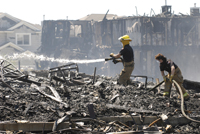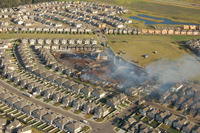
Features
Structural
Training
Rapid fire
There has been a lot of talk lately about residential sprinklers, building codes and lightweight construction products that burn faster than firefighters can get to the scene.
January 6, 2009
By
Laura King
Tackling the dangers of lightweight construction
There has been a lot of talk lately about residential sprinklers, building codes and lightweight construction products that burn faster than firefighters can get to the scene.
And there’s been a lot of preaching about taking action on these kinds of issues.
 |
||
| Photo by The Edmonton Journal. Edmonton firefighters tackle hot spots in the debris after the July 21, 2007, MacEwan Green blaze. |
Edmonton Fire Chief Randy Wolsey has done just that. Many have heard the story about July 21, 2007 – the day Wolsely was to host his youngest daughter’s wedding reception at his home. Wolsey’s pager went off at 5:18 a.m. He could see the flames from his living-room window. A massive residential complex under construction had been set on fire. Eighty firefighters and 20 apparatus responded in the first 20 minutes.
The fire consumed 149 condominium suites and 78 duplexes. It burned so hot that homes up to 90 metres away were damaged by heat, not fire. One woman recounted to fire officials how she heard what she thought was wind, looked out the window and saw a wall of flames. By the time she got her family out through the garage, the house was fully engaged, the fire having burned from the outside in.
The lightweight construcution used in Edmonton’s MacEwan Green housing complex burned so fast that the incident commander chose to protect exposures only.
“It was the right choice,” says Wolsey, who was named the Candian Association of Fire Chiefs top chief of 2007.
After four such fires and $37 million in damages, Wolsey called for change, opting to postpone his planned 2007 retirement until he succeeded in having sections of the Alberta building code rewritten.
Wolsey retires March 31, the building code is being amendded and 18 of 22 recommendations by a handful of fire-service experts known as the high-intensity residential fires working group have been accepted by the province of Alberta.
Most Canadian firefighters are well aware that this kind of rapid fire spread is a relatively new phoenomenon and that most provincial building codes remain based on the 1957 St. Lawrence Burns Operations on homes built in the early part of the 20th century.
 |
||
| Photo courtesy Edmonton Fire Rescue Services Heat from the massive MacEwan Green fire damaged buildings up to 90 metres away. |
Engineered wood releases BTUs faster than traditional sawn lumber, making it difficult for firefighters to extinguish established fires, but new data from Underwriters Laboratories (www.ul.com/fire/structural.html) on the structural stability of engineered lumber confirms what Wolsey and others knew from experience – that lightweight construction burns in less than four minutes, leaving firefighters no time to safely enter a structure to save occupants or contents.
“In fact, everything that we had anecdotally been saying is now confirmed and is actually worse than we had said,” Wolsey said. “The truth is that we hadn’t been exaggerating, we had been understating it. The good part is that we now have this scientific evidence to back up the code changes that are necessary for the safety of our community.”
Through a grant provided by the U.S. Department of Homeland Security, Underwriters Laboratories compared lightweight construction – non fire-rated lightweight floor and roof construction assemblies – with legacy (old fashioned) construction in nine tests. According to the online course on lightweight construction on the Underwriters website, the experiments explored how modern fuel loads combined with modern building practices and existing building codes have made a routine house fire one of the most dangerous situations a firefighter can face.
“This should be mandatory for all firefighters to view, to enhance the safety of firefighting operations,” says Wolsey.
The online slideshow is blunt and disturbing, showing in detail how a basement fire destroys the floor above in minutes, how firefighters in smoky conditions might fail to notice floor deflection, and proving that thermal imaging cameras fail to detect the fire beneath the floor. The Underwriters presentation concludes that the fire service needs to push for mandatory residential sprinklers and to change codes to require the following:
• That all floor and roof systems are protected with a mininum one-hour fire rating;
• That truss girders are protected with a one-hour fire rating;
• That draft-stopping requirements be changed to limit concealed spaces to no more than 500 square feet;
• And that draft stopping exemptions are eliminated.
The presentation also concludes that:
• Lightweight assemblies, whether protected or not protected, fail significantly faster than legacy assemblies;
• Legacy assemblies tend to fail locally while lightweight assemblies tend to fail globally;
• Sensory indicators (sight, sound and touch) are not relilable indicators of impending collapse;
• Views and data from thermal imagers are not reliable indicators of impending collapse.
Closer to home, the National Research Council and the Institute for Research in Construction released on Dec. 15 a report on the fire performance of Canadian homes. The study involved several tests on unprotected floor assemblies in basement fires. The report concludes that failure of lightweight floor components occurred between 35 per cent and 60 per cent faster than solid wood assemblies. It also concludes that more research is needed on the required egress time for single familiy homes.
 |
|
| Photo by The Canadian Press Eighty firefighters and 20 apparatus responded in the first 20 minutes to the MacEwan Green blaze. The fire consumed 149 condominium suites and 78 duplexes. |
Back in Alberta, the building code is being changed to reduce the effects of high-intensity residential fires. The working group recommended that fire-resistant gypsum wallboard be used under vinyl siding instead of the faster-burning oriented strandboard that new homes with attached garages require fire detectors and gypsum wallboard.
Under the amended code, contractors will be required to protect adjacent buildings during high-risk periods of construction, such as when the building frame is exposed. There will also be a new requirement for improved site security.
The changes are being phased in this year and have been forwarded to the Canadian Centre on Code Development to be considered for the national building code, which is due to be reviewed in 2010.
Although Wolsey is hanging up his chief’s hat, one recommendation sent for further study remains a project for others: the recommendation to require smoke detectors in attics of single-family homes to alert residents to fires that start outside, burn up the side of a house and into the attic void. Many of these kinds of fires, Wolsey says, are caused by careless smokers who toss their smouldering butts into planters or on backyard decks.
“Over the last five to 10 years we’ve moved our smokers to the outside,” Wolsey says. “Cigarettes used to be a large component of interior fires. A lot of fires that we’re experiencing happen outside in a planter, burn up the side of the house into the attic and through the roof because there is no smoke detection in the attic.
“Those were, in my view, very needed code changes but given where we’re at in the development of new technology, new products and what I expect for the future, the codes will always need to be under scrutiny to make sure that the products we use to build our homes remain safe.”
That said, Wolsey acknowledges that building codes are rigid and changing them takes years, perseverence and, sometimes, a few angry men.
“There’s lot of pressure to move into the new technologies but the code is not as nimble as the private sector in accepting new techonolgy, “ he says. “OSB, i-joists, silent floors – it has taken years for testing to be done on those products. A lot of that testing is only being done because we made an issue of it.”
Print this page